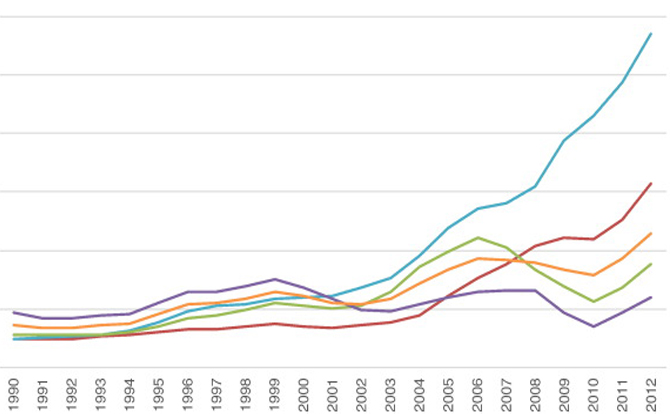
IMPACT OF ICTS ON INCOME GROWTH AT THE BASE OF THE PYRAMID
28 Feb 2016The limited impact of ICTs on income growth in lower- income populations can be partially attributed to their significantly lower ICT adoption. Several measures of ICT penetration are highly correlated with country GDP per capita. These include Internet penetration (correlation coefficient of 0.75 with GDP per capita), fixed broadband subscription penetration (correlation coefficient of 0.74), and active mobile broadband subscription penetration (correlation coefficient of 0.69).
This relationship, where lower income implies lower ICT adoption, is also observed within countries. In the United States, for example, households with an annual income below $30,000 in 2010 were less than half as likely to have broadband Internet at home as those earning more than $75,000 (40 percent versus 87 percent); similarly, individuals in those households were nearly half as likely to use the Internet in general (57 percent versus 95 percent)
While affordability is one barrier to adoption, other factors include education and culture. To counter the possible disparity in the impact of ICTs between lower- and higher-income groups, the most immediate action should be to close the disparity in ICT penetration. Many of the benefits of ICTs are not accruing to lower-income populations because access and adoption are low. Some policy actions are recommended to close the access and adoption gap to increase the positive benefits of ICTs to groups at the base of the economic pyramid:
- Focus public resources and incentives for building broadband Internet access out to rural and underserved communities.
- Remove excess taxation on devices and access, and consider targeted subsidies for certain populations.
- Develop robust ICT training curricula and programs. Increasing digital literacy and training more individuals in how to utilize ICTs will help drive familiarity and adoption, even for basic ICTs such as feature phones. A recent analysis by McKinsey found the lack of user capability and digital illiteracy (in addition to language illiteracy) to be main barriers impeding many of the 60 percent of the global population who are not yet online.
- Focus on closing the gender gap in ICTs. Gender gaps exist in ICT adoption: fewer women and girls than men and boys use mobile phones and the Internet. A wide range of economic and cultural influences drives these gaps, but increasing female participation in ICTs will help spread more benefits to lower-income households.
What people say

A business leader with a clear objective to Build a Legacy through his business acumen and passion to excel, being associated with Dr Tejinder opens up new avenues for learning.

Dr Tejinder Singh , the man who taught me to teach and lead. My first and only professional Guru who would run the mile first and push me to walk that . A wonderful human being and an exceptional professional.

Tejinder is one of the most amazing client/business partner that I have ever met.

I met Bhattia sahib once and found him very friendly,intelligent and very focused head of an efficient organisation.

In my association with Tejinder I have found him to be very frank in his views.He is very strong in his domain knowledge and also has sharp commercial acumen.

I was hired by Tejinder Sir, in the year 2003, which was also the turning point in my career.

My 1st Impression about Mr. Tejinder Singh Bhatia - An Exteremely Confident Professional, Who knows What he is Doing and Where he wants to Reach.

He was a dedicated and sincere person and always followed pragmatic approach while fulfilling his job responsilbilites.

I am priviledge to work under him, he is an excellent Leader where team always ready to work for him even at oddest hour of the day.